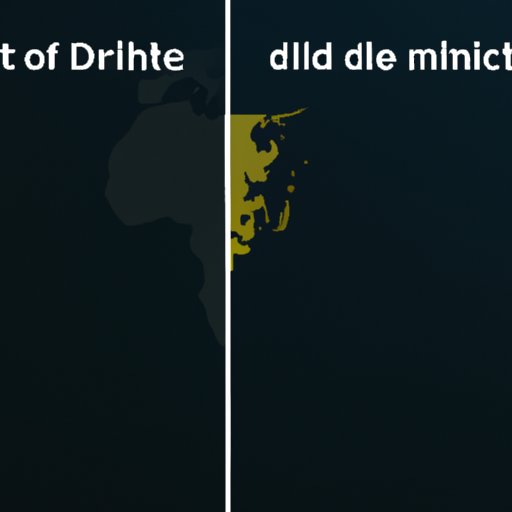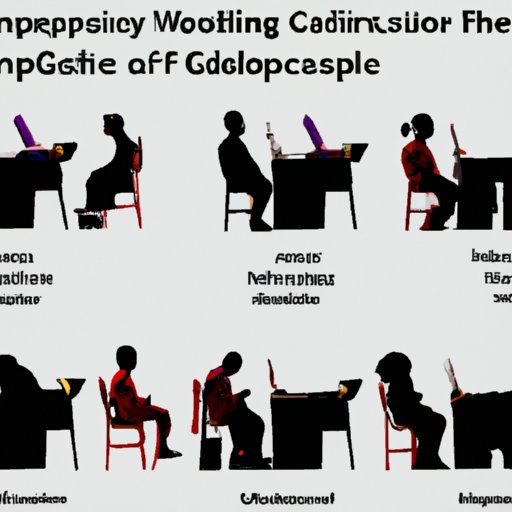Introduction
In a world where technology is rapidly advancing, it can be easy to forget that not everyone has access to the same level of technological resources. This is known as the “technology gap” – the difference between those who have access to technology and those who do not. This gap is closely related to global inequality, as it contributes to disparities in education, employment opportunities, and access to resources. In this article, we explore how the technology gap contributes to global inequality and what can be done to bridge the divide.

Examining the Digital Divide: How Technology Gaps Impact Global Inequality
The digital divide is the gap between those who have access to technology and those who do not. This divide is largely based on geography, income, and age, with access to technology being higher among those who live in urban areas, have higher incomes, and are younger. As a result, the technology gap contributes to global inequality in several ways.
Impacts on Education
One of the most significant impacts of the technology gap is on education. A recent study by the Organisation for Economic Co-operation and Development (OECD) found that “students from disadvantaged backgrounds are two times more likely than their peers to lack access to the digital tools they need to engage in learning activities.” This lack of access to technology puts these students at a disadvantage compared to their peers, as they are unable to take advantage of online educational resources or participate in remote learning opportunities. This contributes to educational disparities and ultimately, global inequality.
Impacts on Employment Opportunities
The technology gap also impacts employment opportunities. Those without access to technology, such as those living in rural areas or those with lower incomes, are at a disadvantage when it comes to finding work. They may not have access to job postings, or they may be unable to apply due to lack of technology resources. According to the World Bank, “the lack of access to technology can limit job seekers’ ability to search for jobs, develop skills, and even apply for positions.” This further contributes to global inequality, as those without access to technology are unable to find employment opportunities that could help them escape poverty or improve their lives.
Impacts on Access to Resources
Finally, the technology gap impacts access to resources. Those without access to technology are unable to take advantage of online services, such as banking, shopping, or medical care. They are also unable to access information about health and wellness, or news and current events. This lack of access to resources limits their ability to make informed decisions, which can have a long-term impact on their quality of life. In addition, it contributes to global inequality, as those without access to technology are unable to fully participate in society.
Bridging the Gap: Strategies for Closing the Technology Divide in an Unequal World
Given the impact of the technology gap on global inequality, it is important to explore strategies for closing the divide. There are three main approaches to bridging the gap: governmental programs and initiatives, private sector solutions, and non-profit initiatives.
Governmental Programs and Initiatives
Governments around the world are taking steps to close the technology gap. For example, the United States government has launched initiatives such as ConnectHome, which provides free or low-cost broadband access to low-income households. Other countries have implemented similar programs, such as India’s Digital India initiative, which seeks to provide internet access to all citizens. These types of programs can help to bridge the digital divide and reduce global inequality.
Private Sector Solutions
In addition to governmental initiatives, the private sector is also playing a role in closing the technology gap. Companies like Google and Microsoft have launched initiatives to increase access to technology in underserved communities. Google’s Project Loon, for example, is a program that provides internet access to remote areas via hot air balloons. Private sector solutions like these can help to bridge the technology gap and reduce global inequality.
Non-Profit Initiatives
Finally, non-profit organizations are also working to close the technology gap. One example is the One Laptop per Child initiative, which seeks to provide laptops to children in developing countries. Non-profit initiatives like these can help to bridge the technology gap and reduce global inequality.

The Cost of Inequality: How Technology Gaps Affect Access to Education and Employment Opportunities
The technology gap contributes to global inequality in several ways, including access to education and employment opportunities. Let’s take a closer look at how the technology gap affects access to these two areas.
Education Disparities
The technology gap contributes to educational disparities, as those without access to technology are unable to take advantage of online educational resources or participate in remote learning opportunities. This puts them at a disadvantage compared to their peers, which can have a long-term impact on their quality of life. According to the OECD, “Students living in households with no access to the internet perform worse in tests than those with access, regardless of their socio-economic status.” This contributes to global inequality, as those without access to technology are unable to access educational resources that could help them break out of poverty or improve their lives.
Job Market Disparities
The technology gap also contributes to job market disparities, as those without access to technology are unable to search for jobs, develop skills, or even apply for positions. This limits their opportunities to find meaningful employment, which can have a long-term impact on their quality of life. According to the World Bank, “The lack of access to technology can limit job seekers’ ability to search for jobs, develop skills, and even apply for positions.” This further contributes to global inequality, as those without access to technology are unable to find employment opportunities that could help them escape poverty or improve their lives.
Connecting the Unconnected: Exploring Solutions to Bridge the Digital Divide
Given the impact of the technology gap on global inequality, it is important to explore strategies for bridging the divide. There are three main approaches to bridging the gap: increased internet access, improved infrastructure, and greater access to technology resources.
Increased Internet Access
One of the most effective ways to bridge the technology gap is to increase access to the internet. Governments, private companies, and non-profit organizations are all working to increase internet access in underserved communities. Examples include Google’s Project Loon, which provides internet access to remote areas via hot air balloons, and the US government’s ConnectHome initiative, which provides free or low-cost broadband access to low-income households. Increasing access to the internet can help to bridge the digital divide and reduce global inequality.
Improved Infrastructure
In addition to increasing access to the internet, it is also important to improve infrastructure in underserved communities. This includes investing in infrastructure such as roads, bridges, and telecommunications networks, as well as providing access to electricity. This type of investment can help to bridge the technology gap, as it will enable those in underserved communities to access the internet and other technology resources.
Greater Access to Technology Resources
Finally, it is important to provide access to technology resources such as computers, tablets, and smartphones. This can help to bridge the technology gap, as those without access to technology will be able to access the internet and other resources. Organizations such as One Laptop per Child are working to provide laptops to children in developing countries, while governments and private companies are investing in initiatives to increase access to technology resources.

Closing the Gap: Achieving Equity Through Technology Innovation
In order to close the technology gap and achieve global equity, it is important to invest in technology research and development. Investing in research and development can help to create new technologies that can bridge the divide, such as affordable internet access or improved infrastructure. It can also help to create new tools that can empower marginalized communities, such as online education platforms or job search engines.
In addition, it is important to use technology to empower marginalized communities. This includes utilizing technology to provide access to resources, such as healthcare, education, and financial services. It also includes leveraging technology to promote social change, such as using data and analytics to identify and address inequalities. Finally, it includes using technology to create a more equitable and inclusive world, such as using artificial intelligence to create fair and unbiased decision-making systems.
Conclusion
In conclusion, the technology gap contributes to global inequality in several ways, including access to education, employment opportunities, and resources. Bridging the gap requires a multi-pronged approach, including governmental programs and initiatives, private sector solutions, and non-profit initiatives. It also requires investing in technology research and development, and using technology to empower marginalized communities. By taking these steps, we can begin to close the technology gap and achieve global equity.
(Note: Is this article not meeting your expectations? Do you have knowledge or insights to share? Unlock new opportunities and expand your reach by joining our authors team. Click Registration to join us and share your expertise with our readers.)
